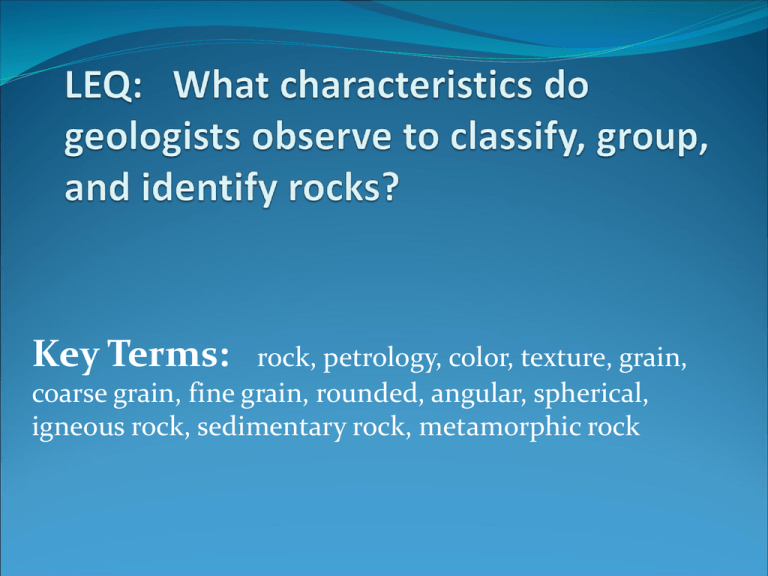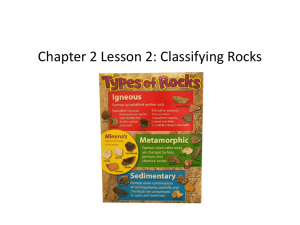How Do Geologists Classify Rock?
advertisement

Key Terms: rock, petrology, color, texture, grain, coarse grain, fine grain, rounded, angular, spherical, igneous rock, sedimentary rock, metamorphic rock Rocks Please turn to page 45 in your textbook. Rocks are not minerals because they do not have all of the characteristics of a mineral. Rocks are mixtures made of Minerals Other materials (pieces of other rocks or organic material). Geologists collect and study samples of rock in order to classify and group them. Stop : Complete Classifying Rocks Power Point Notes Page 1 Part A (Before Continuing) 2 Petrology Petrology is the study of the: Petrology is done through the: • Origin (how did the rock form) of the rock. • Genesis (after forming how did the rock change through time) of the rock. • • • • • Description of the rock. Analysis of the rock. Classification of the rock. Where they occur. Theories of their origin. Stop : Complete Classifying Rocks Power Point notes page 1 Part B Before Continuing 3 Studying The Characteristics of Rock When studying a rock sample, geologists observe the 3 characteristics of the rock. Color Texture Mineral Composition Using these characteristics, geologists can classify a rock according to: The rock’s origin (where it formed) And how the rock formed. Stop : Complete Classifying Rocks Power Point Notes page 1 Part C Before Continuing 4 Stop Pick up a copy of the “Classifying Rocks Power Point Worksheet 1” before continuing. 5 1. Color The overall color observed when the rock is observed visually. e.g. red-brown, grey-black, brown, grey, yellow-brown, grey-blue, etc. Not only is the color of the rock observed, but also the shade of the color. Dark shaded Light shaded 6 7 Rock Color Activity You will use Classifying Rocks Power Point Worksheet 1 part A for this activity. On the following slide, link to the picture of each rock sample. After linking to the photo, use the color chart on the previous slide. Try your best to determine the color and the number for each of the rocks observed. Complete the chart on part A of your worksheet. 8 Rock Color Activity Rock Samples (click on the sample to link to the picture). Rock Sample 1 Rock Sample 2 Rock Sample 3 Rock Sample 4 Rock Sample 5 Stop : Complete Classifying Rocks Power Point Worksheet 1 Part A Before Continuing 9 Stop Pick up a copy of the “Classifying Rocks Power Point Notes Page 2” before continuing. 10 2. Texture Open your textbook to page 46. The look and feel of the rock’s surface. Very useful in identifying the rock. The texture of the rock is determined by the grains that make up the rock. A grain is a particle of mineral or other rock. Geologists use a number of terms based on the rock’s grains to describe the texture of Stop : the rock. Complete Classifying Rocks Power Point Notes Page 2 Part A Before Continuing 11 Descriptive Grain Terms Grain Size What size are the grains? Grain Shape Do the grains have a distinct shape? Grain Pattern Are the grains aligned in some kind of pattern? No visible grain Can any grains be seen? Stop : Complete Classifying Rocks Power Point Notes Page 2 Part B Before Continuing 12 Grain Size Coarse grained Grains are large and easy to see. Fine grained Grains are small and can only be seen using a magnifying glass or microscope. No Visable Grain Grains cannot be seen even with a Stop : microscope of hand lens. Complete Classifying Rocks Power Point Notes Page 2 Part C Before Continuing 13 Grain Size Wheel Chart Ex: #3 through 7: Coarse Grain Ex: #8 through 10: Fine Grain 14 Rock Grain Size Activity You will use Classifying Rocks Power Point Worksheet 1 part B for this activity. On the following slide, link to the picture of each rock sample. After linking to the photo, use the grain size wheel chart on the previous slide. Try your best to determine the grain size (coarse, fine, or no visible grain) and the wheel number (if applicable) for each of the rocks observed. Complete the chart on part B of your worksheet. 15 Rock Grain Size Activity Rock Samples (click on the sample to link to the picture). Rock Sample 1 Rock Sample 2 Rock Sample 3 Rock Sample 4 Rock Sample 5 Stop : Complete Classifying Rocks Power Point Worksheet 1 Part B Before Continuing 16 Grain Shape Grains vary in shape. Shape of the mineral crystals that make up the rock. Shape of the fragments of other rocks. Rounded grain Jagged (angular) grain Stop : Complete Classifying Rocks Power Point Notes Page 2 Part D Before Continuing 17 18 Rock Grain Shape Activity You will use Classifying Rocks Power Point Worksheet 1 part C for this activity. On the following slide, link to the picture of each rock sample. After linking to the photo, use the grain shape chart on the previous slide. Try your best to determine the grain shape and how spherical the grain is for each of the rocks observed. Complete the chart on part C of your worksheet. 19 Rock Grain Shape Activity Rock Samples (click on the sample to link to the picture). Rock Sample 1 Rock Sample 2 Rock Sample 3 Rock Sample 4 Rock Sample 5 Stop : Complete Classifying Rocks Power Point Worksheet 1 Part C Before Continuing 20 Grain Pattern The grains in a rock often form patterns. Flat layers (like stacks of pancakes) Wavy swirling patterns Banded rows of different colors In petrology, a rock whose grains form a layering or banded pattern are known as foliated. In contrast, some have no pattern at all and the grains occur randomly throughout the rock. In petrology, a rock whose grains form no pattern are nonbanded and are known as non foliated. Stop : Complete Classifying Rocks Power Point Notes Page 2 Part E 21 Before Continuing Rock Grain Pattern Activity You will use Classifying Rocks Power Point Worksheet 1 part D for this activity. On the following slide, link to the picture of each rock sample. After linking to the photo, look to see if the grains form a pattern. Complete the chart on part D of your worksheet. 22 Rock Grain Pattern Activity Rock Samples (click on the sample to link to the picture). Rock Sample 1 Rock Sample 2 Rock Sample 3 Rock Sample 4 Rock Sample 5 Stop : Complete Classifying Rocks Power Point Worksheet 1 Part D Before Continuing 23 No Visible Grains Cannot see any grains even with the use of a magnifying glass or microscope. 24 3. Mineral Composition Geologists identify the minerals that make the rock. Often done with using a small slice of the rock and viewing the slice under a microscope. Geologists also use some of the tests that are used to identify minerals. 25







